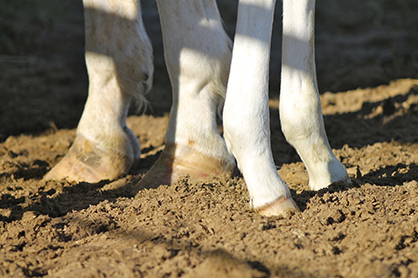Using Ultrasound to Predict Outcome of Tendon Injury
A new technique that uses ultrasound to predict a racehorse’s likelihood of a return to racing after a tendon injury has been developed by researchers at the University of Nottingham, Oakham Equine Hospital and the world-famous Hong Kong Jockey Club.
In this unique collaboration, the team has created a scoring system for grading tendon injuries in racehorses when they first occur and used this in a large study to determine which ultrasound features will predict whether or not the horse will successfully race again after rehabilitation.
The new system will significantly improve racehorse welfare in both the short and long term. It will enable vets and racehorse trainers to make early and informed decisions on a horse’s future – whether to prescribe rest and recovery before racing again, rehabilitation for another career or immediate retirement.
The researchers have also been working with a leading veterinary ultrasound company, BCF Technology, to develop an App vets can use to record their ultrasound findings using the new scoring system.
Horse racing is an ancient and global sport with Thoroughbred racing a multi-million pound industry that has been dubbed ‘the Sport of Kings.’ There are around 14,000 horses currently in training in the UK alone1. Not all will end up competing on the 60 racecourses throughout Britain, but of those who do a relatively small percentage will suffer a tendon injury. A high proportion of these will not be fit to race again and will have to be retrained for an alternative career.
Standard treatment for tendon injury in a racehorse is the 3 ‘Equine Rs’ – Rest (until able to race again), Rehabilitation (toward an alternative career) or Retirement. In the new study, published in TBC, researchers from Oakham Equine Hospital in the East Midlands, the Hong Kong Jockey Club and the Nottingham Veterinary School developed a statistical model which related ultrasound changes in 469 racehorses when the tendon injury first occurred to the likelihood of that horse making a successful return to racing (defined as completing at least 5 races after rehabilitation).
The data used in the study are unique in that the Hong Kong Jockey Club has standardized recording of clinical records for all racehorses over many years. All racehorses train and race on the same track, live together in the same racing yard, and are attended to by the same vets. These characteristics enabled the researchers to perform a large-scale cohort study with long-term follow up of each injured racehorse. Their predictive model found that clinicians should concentrate on two main characteristics of the tendon injury, each easily assessed by ultrasound at first presentation; the cross-sectional area of the lesion and the extent of disruption to the normally highly-ordered pattern of tendon fibres.
Dr Rafael Alzola, equine surgery resident at the Nottingham Veterinary School and Oakham Veterinary Hospital, said: “Ultrasound is a quick and easy method of assessing tendon injuries, widely available across veterinary practices. The scoring system makes evidence-based decision making on long term outcomes feasible and accessible to equine veterinary practitioners.”
Professor Chris Riggs, Head Vet at the Hong Kong Jockey Club added: “Decisions on future careers for racehorses have to be carefully considered by the horse’s owner, trainer and vet, working together. This study is important from a welfare perspective, as it provides the information to help them make decisions which are best for the horse’s long term welfare, as soon as the injury occurs.”
Professor of Veterinary Surgery at the Nottingham Veterinary School, Sarah Freeman, said: “We have worked with leading ultrasound company BCF to develop an App based on the scoring system. This will help develop future research studies so similar work can be done for injuries in horses competing in other disciplines.”
The Visits ToDo App produced by BCF Technology gives veterinary surgeons and technicians the tool to record animal health and diagnostics in one place while they are out in the field. More details are available here.












